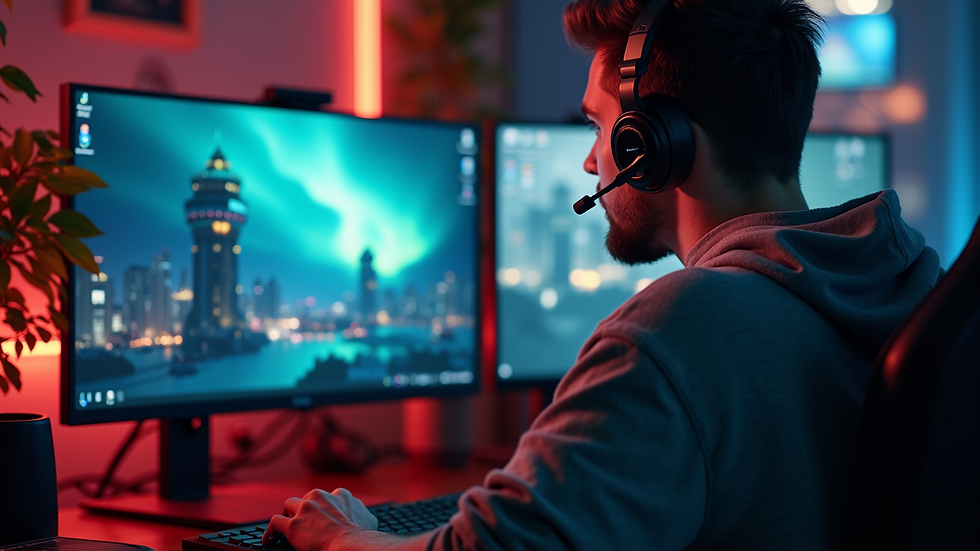Behind the Scenes: Our Game Development Journey
- Ashborn Interactive
- Aug 17
- 3 min read
Creating a video game is like crafting a complex puzzle. Each piece must fit perfectly to create a beautiful picture. Our journey in game development has been filled with challenges, triumphs, and countless lessons. In this post, we will take you behind the scenes of our game development process, sharing insights and experiences that shaped our project.
The Spark of an Idea
Every great game starts with an idea. For us, it began during a casual brainstorming session. We wanted to create something unique, something that would resonate with players.
We tossed around various concepts, from fantasy worlds to futuristic settings. After much discussion, we settled on a theme that combined adventure and mystery. This theme would allow us to explore rich storytelling while engaging players in exciting gameplay.
The initial idea was just the beginning. We knew we had to flesh it out.
Building the Team
With our idea in hand, we needed a team to bring it to life. We sought out individuals who shared our passion for gaming and creativity.
Our team consists of:
Game Designers: They shape the gameplay mechanics and overall experience.
Artists: They create the visual elements, from characters to environments.
Programmers: They write the code that makes everything work.
Sound Designers: They craft the audio that enhances the atmosphere.
Finding the right people was crucial. We wanted a mix of experience and fresh perspectives.
Concept Development
Once our team was in place, we moved on to concept development. This phase involved brainstorming sessions, sketches, and prototypes.
We created mood boards to visualize the game's aesthetic. These boards included color palettes, character designs, and environment concepts.
Prototyping was essential. We built simple versions of our game to test ideas. This allowed us to see what worked and what didn’t.
Storytelling and World-Building
A compelling story can elevate a game. We wanted our players to feel connected to the characters and the world.
We spent weeks developing the narrative. We created character backstories, plot twists, and dialogue.
World-building was equally important. We designed a rich universe with its own rules and lore. This depth would immerse players in the experience.
Designing Gameplay Mechanics
With the story in place, we turned our attention to gameplay mechanics. We wanted to create a balance between challenge and fun.
We brainstormed various gameplay elements, such as puzzles, combat systems, and exploration. Each mechanic had to serve the story and enhance the player experience.
Playtesting was crucial during this phase. We gathered feedback from players to refine our mechanics.
Art and Visual Design
Visuals play a significant role in game development. Our artists worked tirelessly to create stunning graphics.
We focused on creating a unique art style that matched our theme. This included character designs, environment art, and animations.
The visual elements had to be cohesive. We wanted players to feel like they were stepping into a living, breathing world.
Sound Design and Music
Sound design is often overlooked, but it is vital for immersion. Our sound designers crafted audio that complemented the visuals.
We created sound effects for actions, environments, and character interactions.
Music also played a key role. We composed a soundtrack that matched the game's tone, enhancing emotional moments and building tension.
Testing and Feedback
Testing is a critical part of game development. We conducted multiple rounds of testing to identify bugs and gather player feedback.
We invited players to try our game and share their thoughts. This feedback was invaluable. It helped us understand what worked and what needed improvement.
We made adjustments based on player experiences, ensuring our game was enjoyable and engaging.
Launching the Game
After months of hard work, the launch day finally arrived. We were excited and nervous.
We prepared marketing materials, trailers, and social media posts to promote our game.
The response from players was overwhelming. Seeing people enjoy our creation made all the effort worthwhile.
Reflecting on the Journey
Looking back, our game development journey was filled with ups and downs. Each challenge taught us something new.
We learned the importance of teamwork, communication, and adaptability.
Our passion for gaming drove us to create something special. We hope our journey inspires others to pursue their dreams in game development.
Final Thoughts
Creating a game is a labor of love. It requires dedication, creativity, and collaboration.
We are proud of what we accomplished and excited for what lies ahead.
As we continue our journey, we look forward to sharing more stories and insights from the world of game development.

Our adventure is just beginning, and we invite you to join us on this exciting path. Thank you for being a part of our journey!


Comments